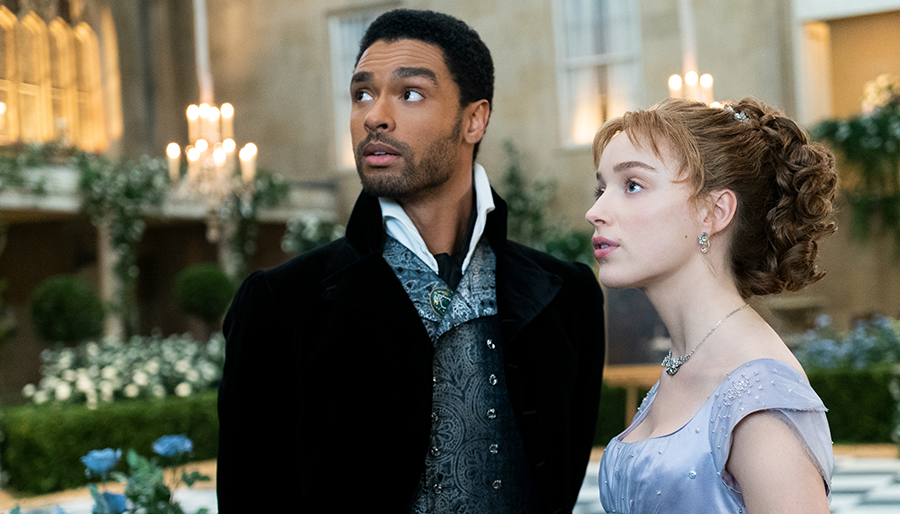To include an anachronism in a piece of historical fiction, a film or a television program has traditionally been seen as an embarrassing mistake. Mel Gibson wearing a kilt in Braveheart is probably the most well-known example: the kilt wasn’t worn in Scotland until the 18th century.
The colour-blind casting and use of contemporary music in Bridgerton are both examples of anachronisms. Image credit: Liam Daniel/Netflix
However, for a new group of writers and creators of historical fiction, film, television and drama, anachronisms are not mistakes, but deliberate stylistic choices.
From Henry VIII’s wives singing about their location settings in the hit pop musical Six to Emily Dickinson twerking in Dickinson on AppleTV+, there is now a deliberate embrace of anachronisms in historical fiction. Think about Bridgerton and its use of orchestral arrangements of popular songs, such as Billie Eilish’s ‘bad guy’ and Ariana Grande’s ‘thank u, next’.
In my book The Anachronistic Turn: Historical Fiction, Drama, Film and Television, I argue that deliberate, or what I call creative anachronisms can open space for us to think about history and fiction in new ways. The creative anachronism can ask us to think about the resonances between past and present and remind us that all fictions about the past are simply that: fictions. Historical fiction often tells us more about the moment it’s written than it does about the past, and anachronistic historical fictions remind us of that by being very explicit about it.
The genesis of my book came from viewing Dickinson. I had just finished my previous monograph, on historical fictions about Anne Boleyn, and was burnt out on historical fiction as a genre. I wanted to see something that engaged with our ideas about the past in new and interesting ways.
Alena Smith, the creator of Dickinson, told me that she used the 1850s setting of the series as an “Instagram filter” on the past. In other words, the past is used as a reflection of us.
Dickinson was that breath of fresh air. In the opening episode, Emily Dickinson (played by Hailee Steinfeld) is clad in white, writing in the early hours of the morning. For anybody who knows their Emily Dickinson mythology, so far, so expected. When her younger sister Lavinia (Anna Baryshnikov) interrupts to ask her to fetch water from the well, Emily questions why her brother Austin can’t get it instead. “He’s a boy,” Lavinia explains. “It’s not his job.”
“That’s such bullshit,” Emily replies, slamming the door. From that moment on, I was hooked. I began to notice how many pieces of historical fiction used contemporary language and references, from the use of contemporary language in the ABC series Gold Diggers (“Fire up, bitches!” in a show set in 1853) to Catherine the Great knowing how to make a Bloody Mary in The Great, even though that particular beverage wasn’t invented until the 1920s.
One of the forerunners of this style of historical filmmaking is Sofia Coppola’s Marie Antoinette. In a memorable scene in the film, a pair of Converse sneakers are seen lying amid a group of the French Queen’s shoes. Another forerunner is the film A Knight’s Tale, in which the crowd at a medieval joust sings, ‘We Will Rock You’. I argue that the turn towards this anachronistic style can be dated roughly to the turn of the 21st century, but has accelerated in the past five years, in particular.
- Colour-blind casting delivers fresh take on Anne Boleyn: review
- Ramses: golden treasures of the superstar pharaoh come to Sydney
Alena Smith, the creator of Dickinson, told me that she used the 1850s setting of the series as an “Instagram filter” on the past. In other words, the past is used as a reflection of us.
Instead of differentiating past and present, or imagining the past as strange or unknown, anachronistic historical fictions such as Dickinson ask us to think about how we might see ourselves in the past.

Dr Stephanie Russo (pictured) is an Associate Professor of Literature in the Department of Media, Communications, Creative Arts, Language, and Literature, and is the author of The Anachronistic Turn: Historical Fiction, Drama, Film and Television.



